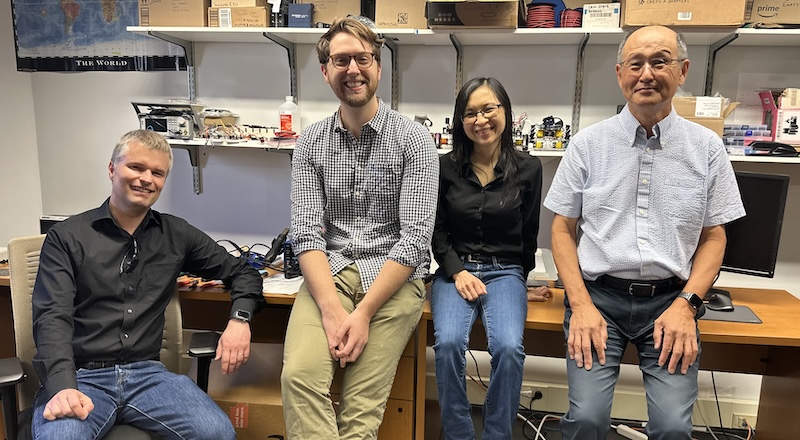
Robert Gifford, a doctoral candidate with the Penn Research in Embedded Computing and Integrated Systems Engineering (PRECISE) Center, is at the forefront of revolutionizing real-time systems on modern multi-core computers. Working with Linh Thi Xuan Phan and Andreas Haeberlen, Associate Professor and Professor in the Department of Computer and Information Science (CIS), respectively, Gifford is developing solutions that could significantly enhance the safety and predictability of systems that power critical applications, from aerospace to medical devices.
Real-time systems, like those in pacemakers or flight control systems, must respond to inputs within strict timeframes to ensure safety. Traditionally, these systems are built using single-core processors, where tasks are isolated and executed within predictable amounts of time. However, as multi-core processors have become common, new challenges have emerged because of cross-core resource sharing, which can add unpredictable delays. Gifford’s research is developing new, innovative ways to allocate these shared resources on multi-core systems, so that critical tasks can remain predictable and safe while fully leveraging the power of modern hardware.
Tackling the Challenges
Gifford’s first major contribution is Dynamic Resource Allocation (DNA), a groundbreaking technique for distributing resources in soft real-time multicore systems. Before DNA, these systems typically used a static approach — shared resources like CPU, cache and memory bandwidth were allocated to computational tasks only once, using their worst-case requirements, even if any computational tasks’ actual requirements varied significantly during different phases.
Gifford and his team introduced a dynamic allocation method that can redistribute resources on the fly, based on the current demands of each task. This approach led to a significant improvement in efficiency, allowing the system to safely run more tasks simultaneously.
In short, DNA disproved a long-standing belief that dynamic resource allocation would be too resource-intensive and inefficient. Gifford’s work demonstrated that, with the right level of granularity, dynamic allocation can substantially improve system performance and safety.
“We were surprised by just how much we could push the system in terms of scheduling more work,” Gifford recalls. “It was a real breakthrough in showing that dynamic resource allocation wasn’t just feasible but could actually outperform static methods.”
Building on the success of DNA, Gifford broadened his focus to multi-mode systems with Omni, which combines a novel algorithm and a test for scheduling tasks. Multi-mode systems switch between different operational modes — like an autonomous vehicle adapting its behavior when moving from a highway to a crowded urban street. Each mode can have different timing requirements, and transitions between modes can be challenging to schedule safely.
Omni addresses this challenge by finding an optimal resource allocation for each mode while ensuring that the mode transitions remain safe and predictable. Just as with DNA, the result is a system that safely handles more demanding tasks, but now also accounts for dynamic mode changes over time.
“With Omni, we were able to use the same hardware to safely schedule substantially more demanding tasks and transitions, compared to competing systems,” Gifford explains. “System designers can use Omni to schedule their adaptive system on less powerful and power-hungry hardware.”
The culmination of Gifford’s work to date is DECNTR, which takes the ideas from Omni even further by integrating control theory into the resource allocation process. DECNTR allows for the safe delay of task deadlines during mode transitions, enabling far better resource allocations without the tradeoffs that Omni requires. By co-designing the system’s control and scheduling mechanisms, DECNTR offers a more holistic and effective solution to the challenges of multi-core real-time systems.
“Robert’s work stands out for its focus on dynamic and fine-grained resource allocation, a departure from traditional methods that often relied on static allocations or did not account for the changing requirements of tasks over time,” says Haeberlen. “His research also takes a holistic view — it considers the interplay between different system resources and how they can be best managed together to improve overall performance and safety.”
Shaping the Future of Safe, Reliable Systems
As Gifford looks ahead to his anticipated graduation in Fall 2025, the impact of his work is already being felt. His innovations are paving the way for safer, more efficient real-time systems that can meet the demands of today’s complex, multi-core computing environments.
“Ultimately, I hope that my research can help ensure that the systems we rely on for safety and critical operations can keep pace with technological advancements without compromising predictability and reliability,” Gifford concludes. “It’s about making sure that, as we push the boundaries of what’s possible with technology, we’re doing so in a way that enhances the safety and reliability of critical systems for everyone.”
The impact of Gifford’s work cuts across multiple fields, as multi-core processors find more and more applications. “Over the last several years at Penn, Robert’s research has made significant contributions to the field of real-time systems and has helped to bring these critical technologies into the modern era of multi-core computing,” says Phan. “His work has shown that it is possible to harness the power of multi-core processors while maintaining the predictability and safety that real-time systems need. This has important implications for industries that rely on these systems to operate safely and efficiently — from medical devices to autonomous vehicles.”
Ultimately, Gifford’s work demonstrates what makes the PRECISE Center so unique: a drive for innovation that improves lives. “Robert’s research exemplifies the innovative spirit and technical excellence that we strive for at PRECISE,” says Insup Lee, Cecilia Fitler Moore Professor in CIS and Director of the PRECISE Center. “His work not only challenges long-standing assumptions in the field but also provides practical solutions that are already influencing the design of safer, more efficient real-time systems. We are incredibly proud of his contributions and excited to see the continued impact of his work in the years to come.”
